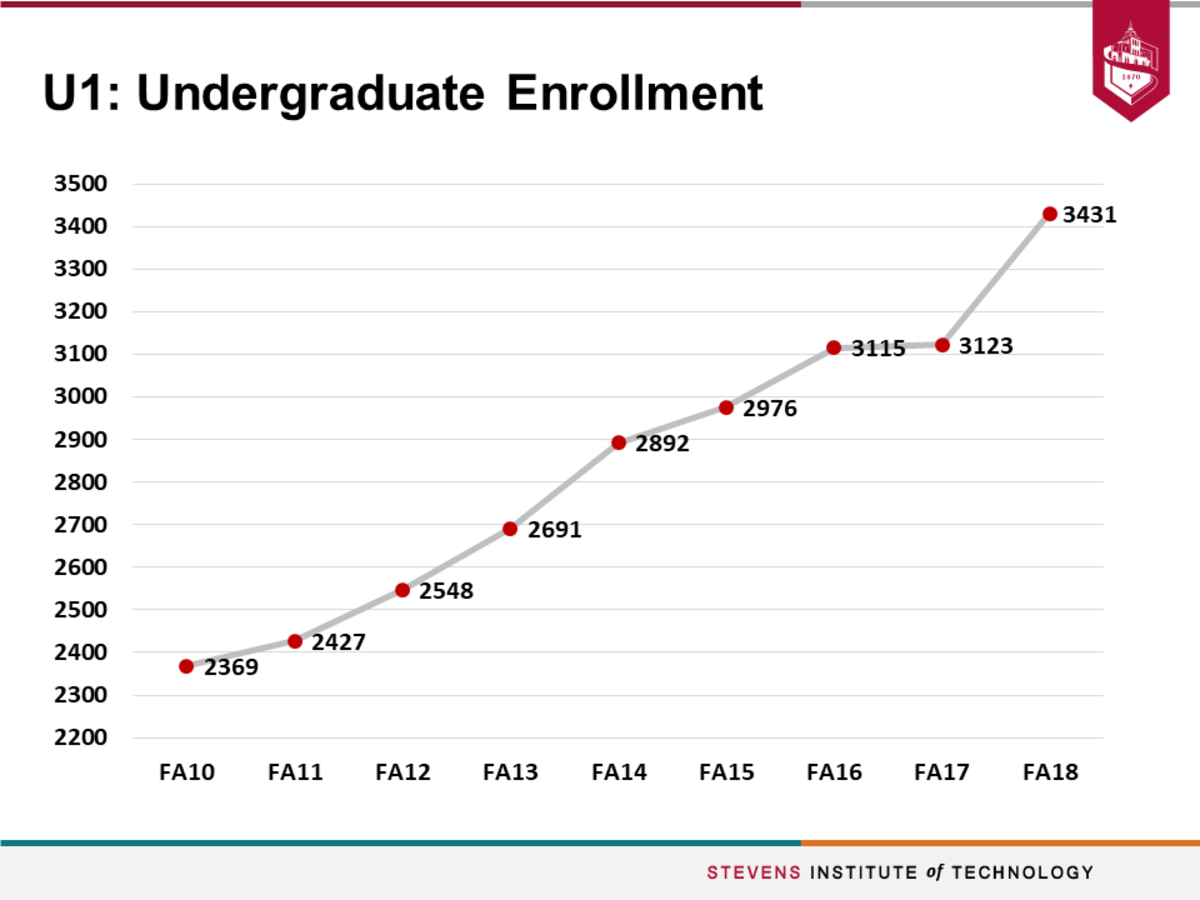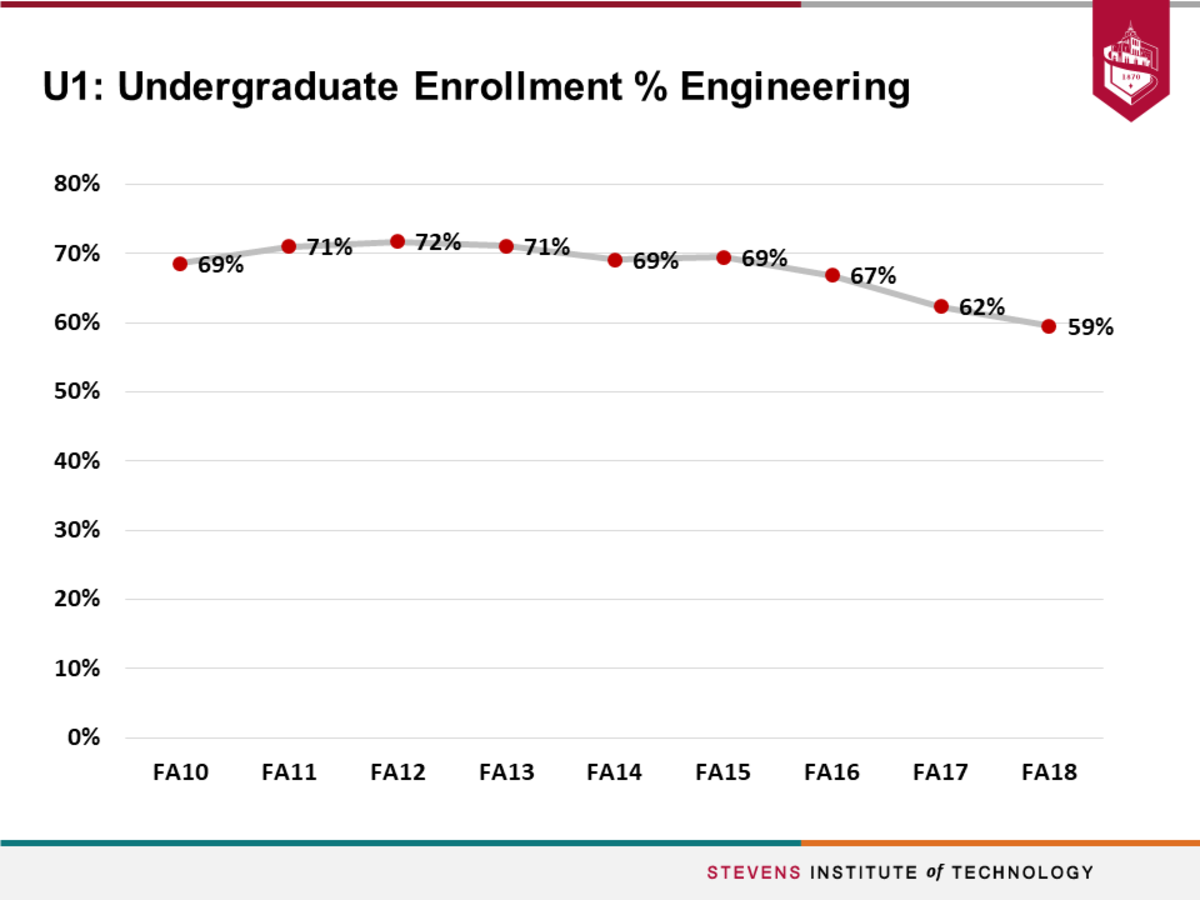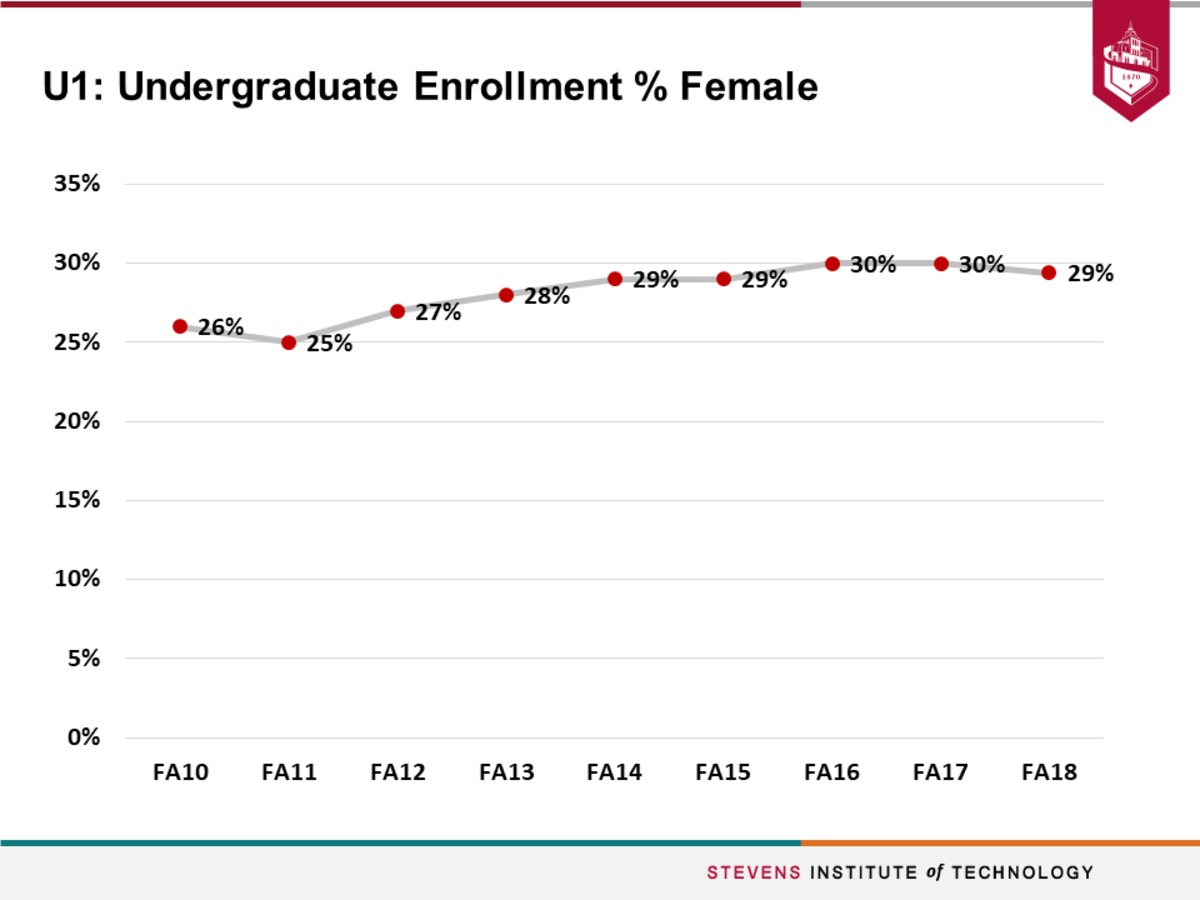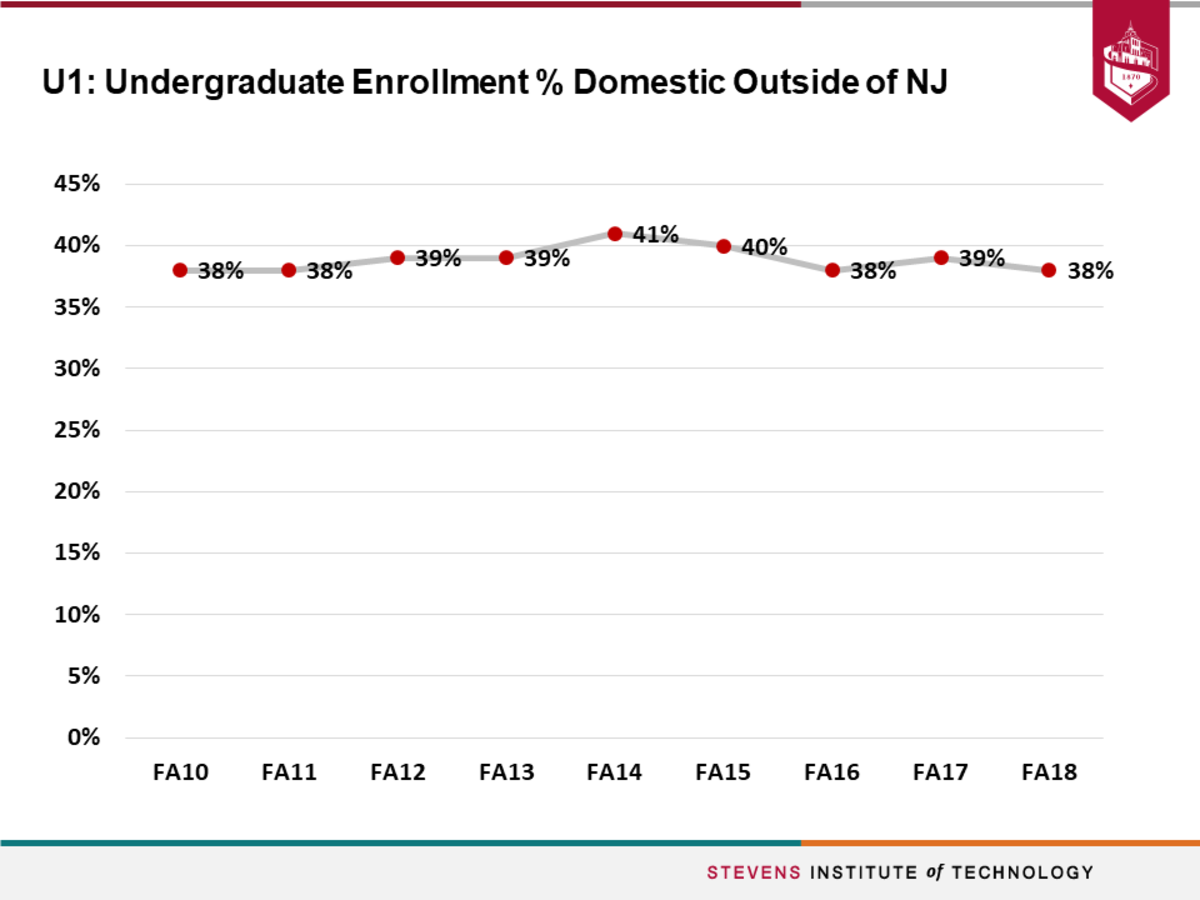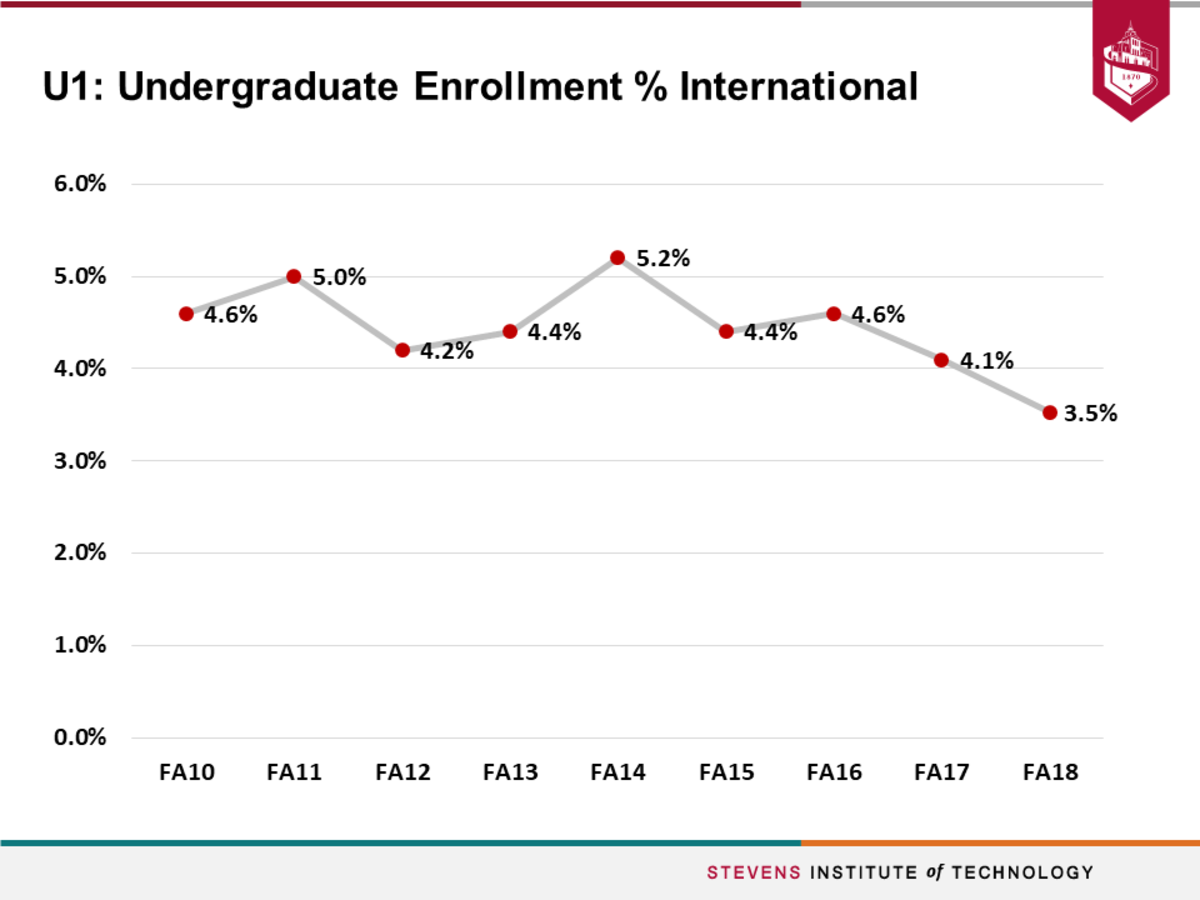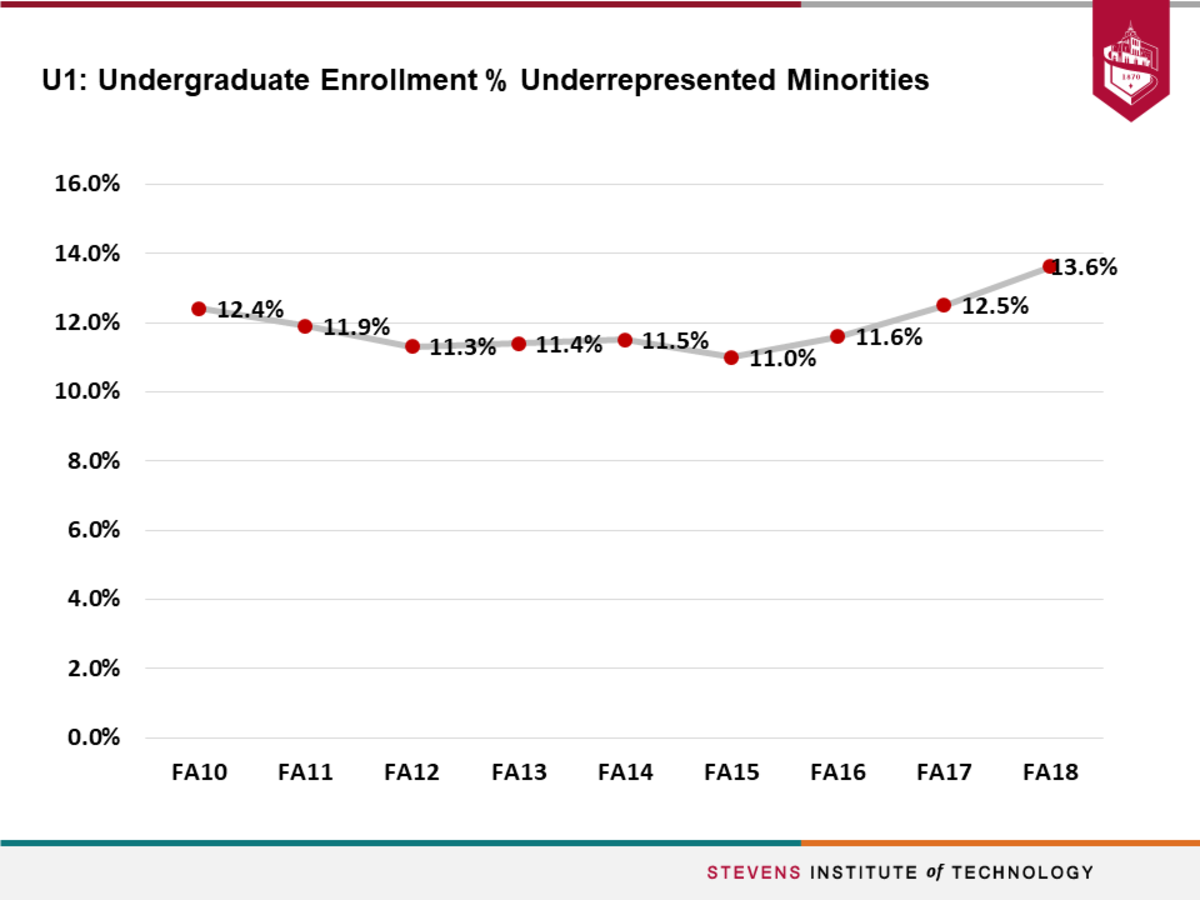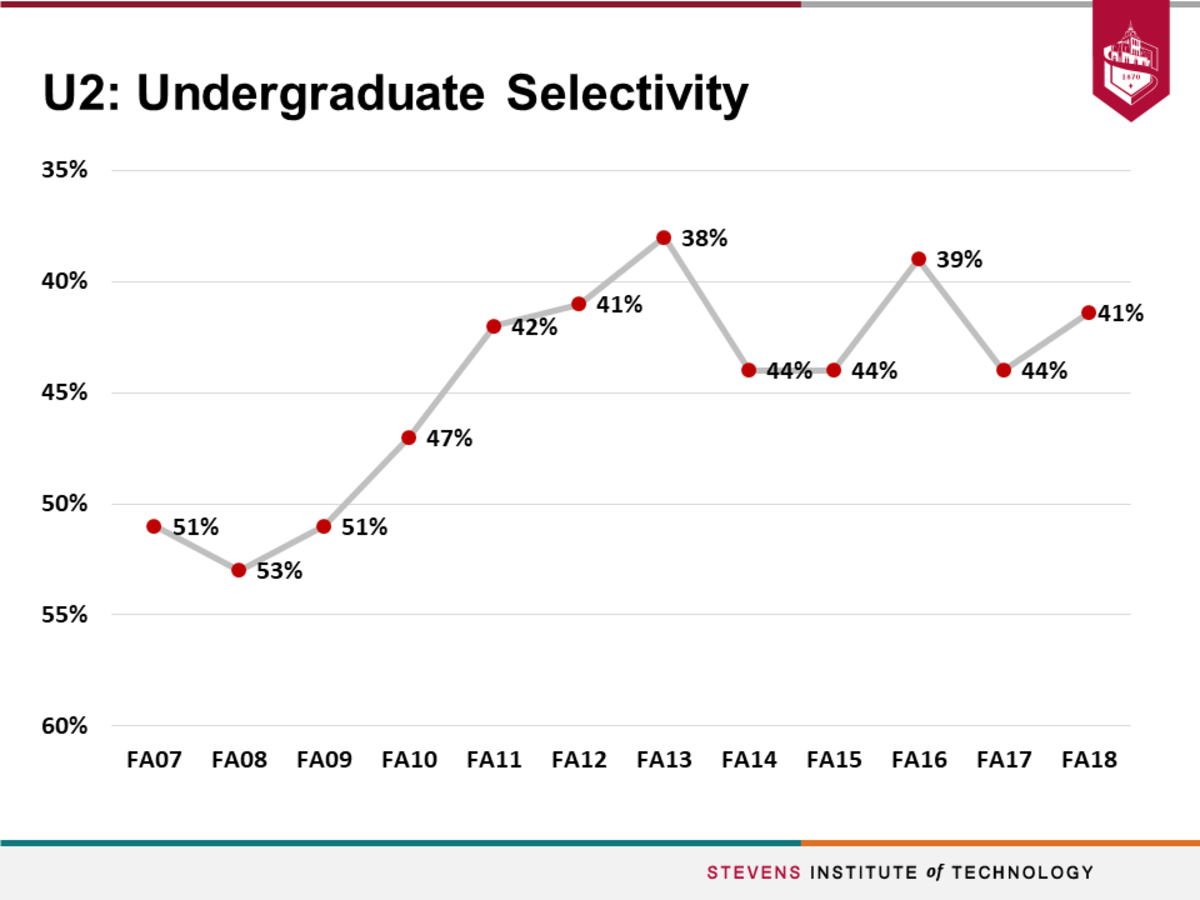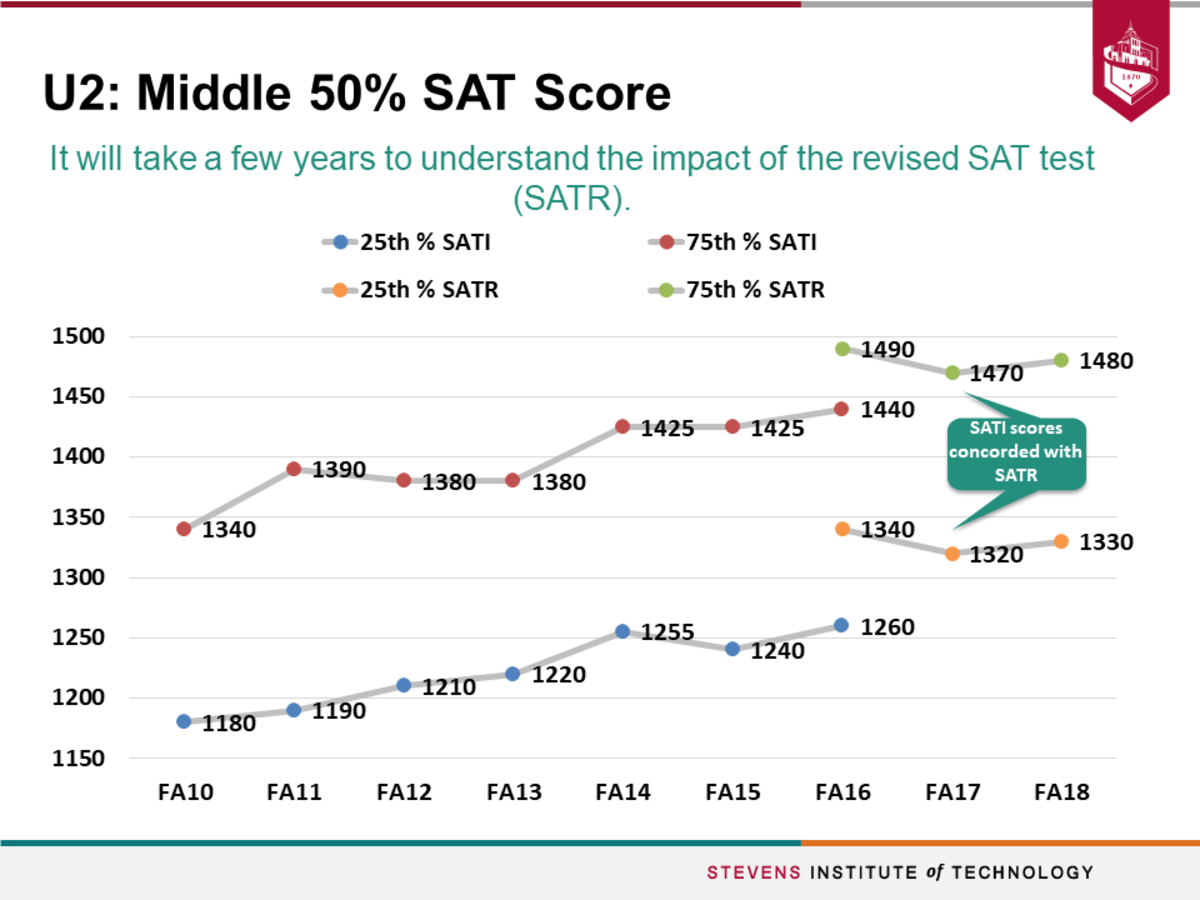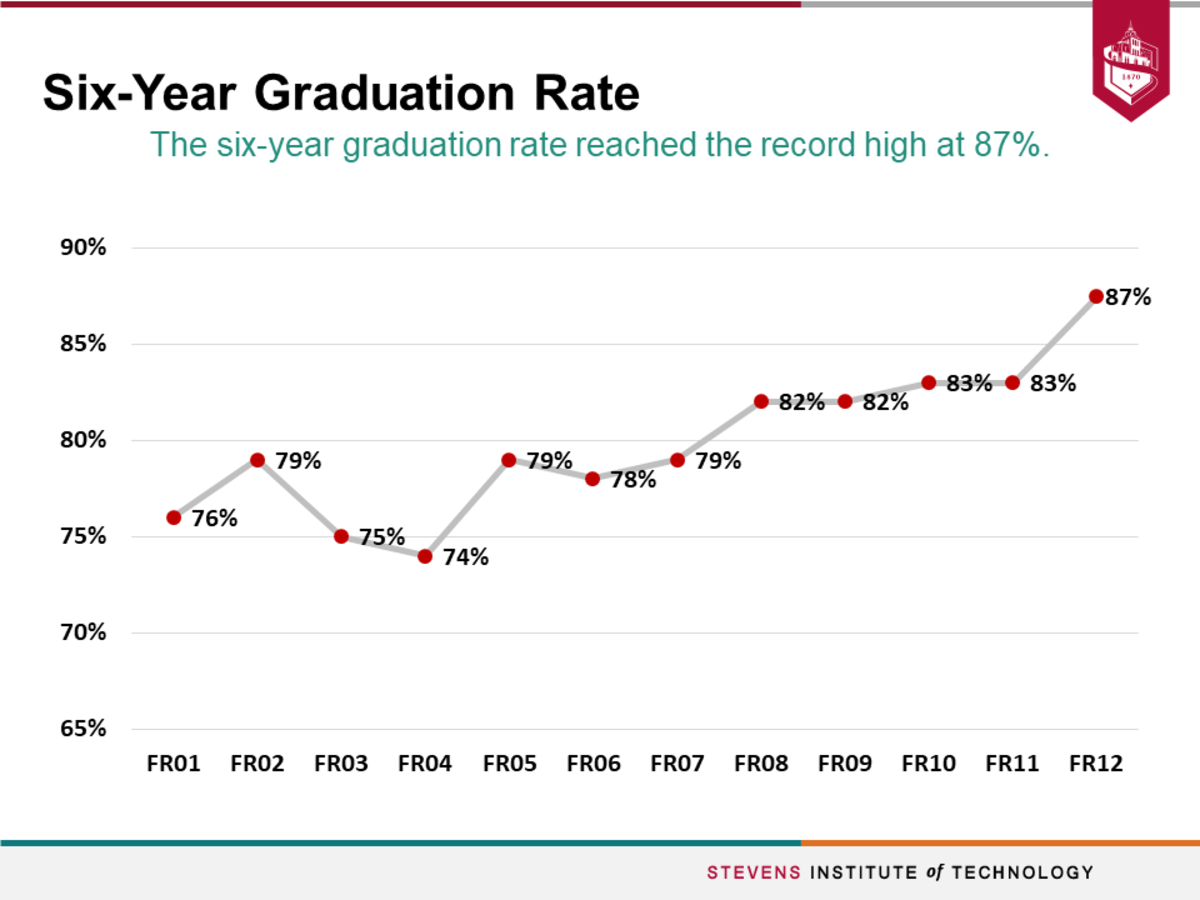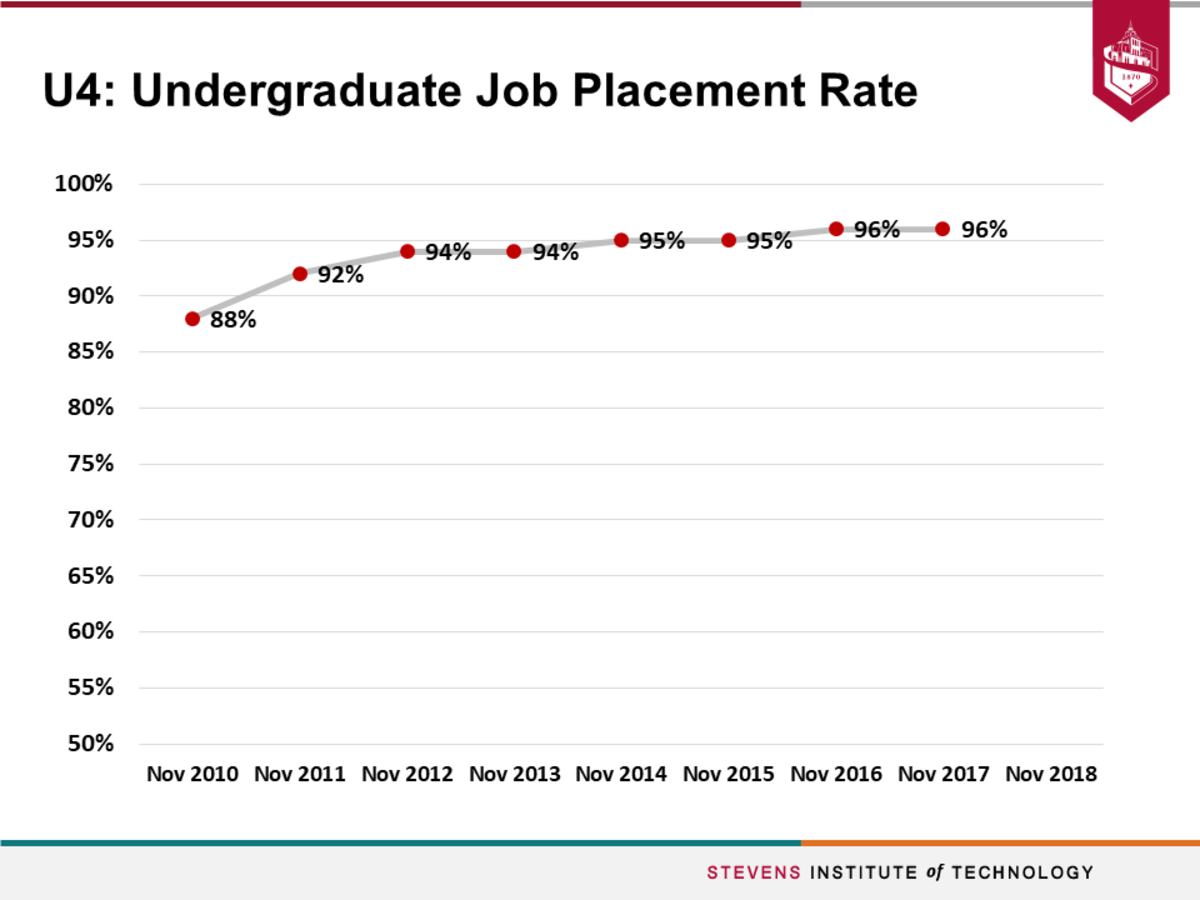Total undergraduate enrollment increased from 3,123 in Fall 2017 to 3,431 in Fall 2018, an increase of 9.8%. Applications increased from 8,335 in Fall 2017 to 9,265 in Fall 2018, and selectivity improved from 44% in Fall 2017 to 41% in Fall 2018. The middle 50 percent SAT score improved once again, from 1320-1470 in Fall 2017 (and exceeding the Fall 2017 goal of 1230-1420), to 1330-1480 in Fall 2018. The freshman-to-sophomore retention rate improved from 94% for students entering in Fall 2016 to 95% for students entering in Fall 2017, and the six-year graduation rate for the freshman cohort of 2012 (Class of 2018) increased to 87% from 83% for the cohort that entered in Fall 2011 (Class of 2017). The placement rate for 2018 graduates who secured full time employment, were admitted to graduate school, entered the military, or secured other outcomes six months after graduation remained at 96%, a record high reached in 2016. Stevens made good progress in balancing undergraduate engineering enrollment with other majors, (59% engineering of total undergraduate enrollment compared to a target of 60% for Fall 2022) and in increasing the percentage of underrepresented minorities in the undergraduate cohort (13.6% in Fall 2018) against a target of 15% for Fall 2022. More progress is needed to increase the percentages of women, out-of-state, and international undergraduates. Significant activities to effect continuous improvement in student-faculty interactions, research-based best practices in teaching, including through the use of technology, and in benchmarking best practices in the evaluation of teaching were implemented.
Goal U1:
By Fall 2022, Stevens will have an undergraduate student enrollment on the order of 4,000 (compared to 2,427 in Fall 2011 and 3,115 in Fall 2016).
The distribution of enrollment in undergraduate majors will be more balanced between engineering programs and other new and existing technology-centric programs, such as in computer science, science, mathematics, business, humanities, social sciences and the arts. As our overall undergraduate enrollment increases, so will numbers of undergraduate engineering students. However, in 2022 we will target that the percentage of undergraduate engineering students will be approximately 60 percent as compared to the Fall 2011 baseline of 72 percent and 67 percent in Fall 2016.
In addition, by recruitment of more diverse freshman cohorts, we will aim to have an undergraduate population that meets the following characteristics:
• At least 35 percent female (compared to 25 percent in Fall 2011 and 30 percent in Fall 2016)
• At least 48 percent from outside of New Jersey (compared to 32 percent in Fall 2011 and 38 percent in Fall 2016)
• At least 8 percent international (compared to 5 percent in Fall 2011 and 4.6 percent in Fall 2016)
• At least 15 percent underrepresented minorities (compared to 12 percent in Fall 2011 and 11.6 percent in Fall 2016)
This increase in undergraduate enrollment will be realized through careful alignment of resources with enrollment distribution, including phasing of an expanded faculty to maintain an appropriate student/faculty ratio across the three schools and college, necessary administrative staffing, necessary additions to our physical infrastructure and to student support services. We will also undertake a careful assessment of any proposed new majors to ensure our continued focus on technology, business and entrepreneurship, and to ensure a continued emphasis on student selectivity, student placement and success, and the overall student experience. We mention here the need to build on successful programs that are contributing to student diversity, selectivity, and success, including our athletic programs and our programs in music and theatre, student government, and community service.
To this end, we will also continue to support and expand programs to imbue integrity and professional ethics to our students, including our student-led Honor System. We believe that the process outlined here will result in Stevens being viewed as a national model for how a university can develop and implement a growth strategy that strengthens the university from every perspective.
OWNERS: PROVOST CHRISTOPHE PIERRE, VICE PRESIDENT MARYBETH MURPHY
Total undergraduate enrollment increased from 3,123 in Fall 2017 to 3,431 in Fall 2018, an increase of 9.8%.
In addition, the following progress was achieved in diversifying undergraduate enrollment for Fall 2018:
Undergraduate engineering enrollment as a percentage of all undergraduate enrollment was 59%, against a target of 60% in Fall 2022, thereby exceeding the goal four years ahead of schedule.
The percentage of women among all undergraduates was 29%, a decrease from 30% in the prior two years, and below the target of 35% for Fall 2022. The percentage of women in the entering freshman class in Fall 2018 was 28%, compared to 29% in Fall 2017.
The percentage of domestic out-of-state undergraduate students was 38%, compared to 39% in Fall 2017, and a target of 48% in Fall 2022. The percentage of out-of-state freshmen in Fall 2018 was 36%, compared to 39% in Fall 2017.
The percentage of international undergraduates is 3.5% in Fall 2018, compared to 4.1% in Fall 2017, and against a target of 8% in Fall 2022. The percentage of international freshmen in Fall 2018 was 2.8%, compared to 2.5% in Fall 2017.
The percentage of underrepresented minorities in the undergraduate cohort was 13.6% in Fall 2018, compared to 12.5% in Fall 2017 and against a target of 15% in Fall 2022. The percentage of underrepresented minorities in the freshman cohort in Fall 2018 was 15.8%, compared to 14.6% in Fall 2017.
A number of new initiatives, including Stevens ACES (Accessing Careers in Engineering and Science), the Clark Scholars program, and scores of specialized outreach and promotional efforts and programs; strategic use of financial aid; as well as a close partnership between the Office of Undergraduate Admissions and the academic enterprise, including the Provost, Deans, Department Chairs, Program Directors, and faculty; have contributed to the progress achieved in Fall 2018.
The faculty hiring plan and targets were aligned with the growth in undergraduate enrollment, in order to ensure that student to faculty ratios remain consistent and students continue to experience the support needed in their academics. In FY18, 30 new faculty were hired starting in AY18-19. With the growth in undergraduate students for Fall 2018, additional resources were allocated to provide instructional and administrative relief to students, faculty, and staff. Furthermore, in FY19, 30 additional faculty position were allocated to keep pace with anticipated growth in enrollment.
Additionally, an evaluation of existing majors has been ongoing; those not aligned with Stevens’ focus, such as Computational Science and History, are being retired. The first class of students for Industrial and Systems Engineering commenced in Fall 2018; potential new majors that are aligned with the Stevens with mission and vision are also being evaluated.
The anticipated opening of the new Gianforte Family Academic Center, in time for the Fall 2019 semester, will also improve the physical infrastructure and space available for teaching and learning. Additionally, in Spring 2018, the academic break for students was reduced. This change, which standardizes the teaching schedule and brings Stevens in line with generally-accepted best practices in higher education, also allows for up to 98 additional course sections, thereby further optimizing classroom space.
Goal U2:
As we expand undergraduate enrollment, we will continue to improve student selectivity and therefore the academic profile of the incoming classes. Specifically,
• the percentage of first-time, full-time undergraduate applicants who are admitted will be 37 percent or less for the Fall 2017 incoming class (39 percent in Fall 2016), and 35 percent or less for the Fall 2022 incoming class, compared to a baseline of 42 percent for the Fall 2011 incoming class; and
• the middle 50 percent SAT score of new freshmen will improve to 1280-1450 for the Fall 2022 incoming class or equivalent ACT score, compared to a baseline of 1190-1390 for the Fall 2011 incoming class and 1260-1440 in Fall 2016.
In the course of expanding our undergraduate enrollment in the next five years, we will remain cognizant of the importance of our goal to concurrently improve student selectivity, enhance the academic profile of incoming students, and achieve the demographic and diversity goals stated earlier. Therefore, we may need to adjust the rate of enrollment growth depending on our success in achieving all other goals.
OWNER: VICE PRESIDENT MARYBETH MURPHY
Applications increased to 9,265 in Fall 2018 compared to 8,335 in Fall 2017, and 41% of students who submitted applications were admitted in Fall 2018, compared to 44% in Fall 2017, against a target of 35% for Fall 2022. The middle 50 percent SAT score improved once again, from 1320-1470 in Fall 2017 (and exceeding the Fall 2017 goal of 1230-1420), to 1330-1480 in Fall 2018.
Continued efforts to increase the size, quality, and diversity of the applicant pool, along with programs such as the Pinnacle Scholars program, the Clark Scholars program, the ACES program, as well as strategic analysis of applicants’ levels of interest, and some changes in deadlines of the application cycle, all contributed to the excellent progress achieved in recruiting the Fall 2018 cohort of students.
Goal U3:
As of Fall 2011, the 6-year graduation rate of the freshman cohort of 2005 was 79 percent and 83 percent for the freshman cohort of 2010. The 6-year graduation rate of our students will improve to at least 88 percent in Fall 2022 (for the freshman cohort of 2016).
OWNERS: PROVOST CHRISTOPHE PIERRE, VICE PRESIDENT MARYBETH MURPHY
The six-year graduation rate for the entering class of 2012 was 87%, an increase from 83% for the class that entered in 2011. This is a record high and nearly approaches the target of 88% for the entering Class of 2016 (to be measured in Fall 2022). In addition, the first-year retention rate for the class that entered in the Fall of 2017 was 95%, compared to 94% for the Class that entered in Fall 2016.
A number of programs implemented both by the Office of Undergraduate Academics (OUA) and the Office of Student Life contributed to recent progress over the last six years, including the recently-established “FirstGen program,” which improves the identification of and increases programming for first-generation students; improved academic advising, including the roll-out of MapWorks; and increased efforts by the Academic Success Center. Key activities have included: assigning tutors to students in need of extra help; recorded versions of academic success workshops that students can access on-demand online; an expanded walk-in tutoring center; and enhancements to the Peer Mentor and Orientation Leader efforts.
Goal U4:
We will maintain a stellar placement record of at least 95 percent for our students, from a baseline of 92 percent of students securing post-graduation outcomes as of November 1, 2011 and 96 percent in Fall 2016.
OWNER: VICE PRESIDENT MARYBETH MURPHY
The placement rate for Class of 2018 graduates who secured full time employment, were admitted to graduate school, returned to their home country, or entered the military six months after graduation remained at 96 percent, a record high reached in 2016.
Employer development efforts are ongoing and have produced: 34 additional companies participating in the cooperative education program; an increase of 17 companies attending the October Internship Fair; and 11 additional companies hiring for full-time employment through the on-campus recruitment program.
Relationships have been established with staff supporting student success in the School of Business, the School of Engineering and Science, and the College of Arts & Letters to facilitate communication regarding career-related programming, services, and employment opportunities to the students of each school.
Graduate student programming, tiered to support the needs of graduate students as they progress through their studies, is now in place. At the request of faculty and students, workshops on job search techniques specific to the needs of the graduate students within each school, are being provided. Accelerated programming for first-semester graduate students in the School of Business was provided, and a workshop on Communication and Business Etiquette will be offered as part of the new mentoring program for first-year graduate students.
Student participation in the undergraduate summer internship program grew by 7% and has been redesigned to support further growth in both student and employer participation. Career Center staff continue to co-teach BT290, a required career development course for sophomore students in the School of Business, which now includes Quantitative Finance students. In collaboration with faculty, dedicated advising for students interested in health-related careers has been established in the Career Center. A Pre-Health Graduate and Medical School guide was created and is now available on the Career Center myStevens site.
Goal U5:
As a student-centric university, faculty engagement in students’ academic experience and excellence in teaching and learning are top priorities. Stevens is committed to continuous improvement in faculty-student interactions, in areas ranging from faculty adoption of research-based best practices in teaching to the use of digital, technology-based and inclusive pedagogical strategies to responsiveness and accessibility to students. By 2018 and with the involvement of faculty, Stevens will develop and/or adopt a holistic approach to evaluating teaching and learning that recognizes the significant variations in teaching environment and that incorporates multiple methods (e.g., peer evaluations, student evaluations, observations, etc.) and sources of data. The approach will be designed to provide timely and meaningful feedback, as well as professional development programming and incentives to ensure all students benefit from high quality teaching and interactions with faculty.
OWNER: PROVOST CHRISTOPHE PIERRE
Progress was made along all dimensions of the Year 6 implementation plan, including improving faculty-student interactions, developing a holistic approach to evaluating teaching and learning, and ensuring that faculty have access to timely and meaningful feedback and professional development programming that will improve their teaching and interaction with students.
More specifically, a benchmarking study of peer institutions to determine best practices in faculty evaluations has been conducted. The conclusion is that multiple methods and sources should be used, including student feedback, peer review, and self-reflection.
Efforts to enhance faculty-student interactions included:
Development of a faculty office hours’ policy, publicized on the Center for Faculty Engagement and Advancement (CFEA) website, and incorporated into the Adjunct Faculty Hiring Packet
Creation of an Advisor Handbook and documents on Advisor and Advisee Roles and Responsibilities, and Best Practices for Faculty Advisors, available through the Office of Undergraduate Academics intranet site
Engagement of the Student-Faculty Alliance (SFA), including sharing strategies for increasing and maintaining membership
Coordination with the Student Government Association and the Office of Student Life to clarify the role of student organization advisors, planned training for new and existing advisors, and created a webpage on the SGA website that will list all organizations actively seeking faculty advisors.
Also, in an effort to enhance feedback and provide guidance on appropriate professional development programming, faculty reports, and recommendations, a series of documents was created and distributed to faculty which include a summary of student feedback and recommended programs, services, and resources for faculty development. Department Chairs and Deans were asked to work with faculty to develop and deploy individual development plans.
Finally, the Office of Undergraduate Academics and the Center for Faculty Engagement and Advancement were included in the first cohort of administrative unit reviews, which commenced in Fall 2018. From this exercise, the practices of “best-in-class” organizations will be reviewed and implemented, as appropriate, in future years.

